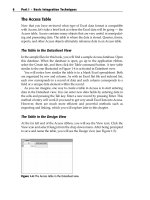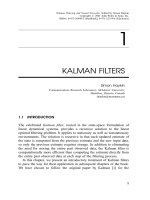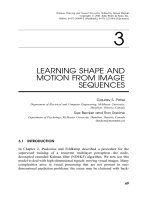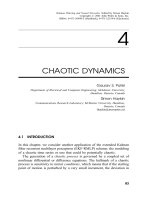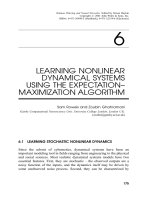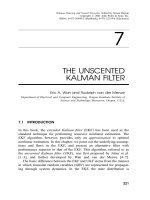Tài liệu Kalman Filtering and Neural Networks - Chapter 1: KALMAN FILTERS doc
Bạn đang xem bản rút gọn của tài liệu. Xem và tải ngay bản đầy đủ của tài liệu tại đây (157.87 KB, 21 trang )
1
KALMAN FILTERS
Simon Haykin
Communications Research Laboratory, McMaster University,
Hamilton, Ontario, Canada
()
1.1 INTRODUCTION
The celebrated Kalman filter, rooted in the state-space formulation of
linear dynamical systems, provides a recursive solution to the linear
optimal filtering problem. It applies to stationary as well as nonstationary
environments. The solution is recursive in that each updated estimate of
the state is computed from the previous estimate and the new input data,
so only the previous estimate requires storage. In addition to eliminating
the need for storing the entire past observed data, the Kalman filter is
computationally more efficient than computing the estimate directly from
the entire past observed data at each step of the filtering process.
In this chapter, we present an introductory treatment of Kalman filters
to pave the way for their application in subsequent chapters of the book.
We have chosen to follow the original paper by Kalman [1] for the
1
Kalman Filtering and Neural Networks, Edited by Simon Haykin
ISBN 0-471-36998-5 # 2001 John Wiley & Sons, Inc.
Kalman Filtering and Neural Networks, Edited by Simon Haykin
Copyright # 2001 John Wiley & Sons, Inc.
ISBNs: 0-471-36998-5 (Hardback); 0-471-22154-6 (Electronic)
derivation; see also the books by Lewis [2] and Grewal and Andrews [3].
The derivation is not only elegant but also highly insightful.
Consider a linear, discrete-time dynamical system described by the
block diagram shown in Figure 1.1. The concept of state is fundamental to
this description. The state vector or simply state, denoted by x
k
,isdefined
as the minimal set of data that is sufficient to uniquely describe the
unforced dynamical behavior of the system; the subscript k denotes
discrete time. In other words, the state is the least amount of data on
the past behavior of the system that is needed to predict its future behavior.
Typically, the state x
k
is unknown. To estimate it, we use a set of observed
data, denoted by the vector y
k
.
In mathematical terms, the block diagram of Figure 1.1 embodies the
following pair of equations:
1. Process equation
x
kþ1
¼ F
kþ1;k
x
k
þ w
k
; ð1:1Þ
where F
kþ1;k
is the transition matrix taking the state x
k
from time k
to time k þ 1. The process noise w
k
is assumed to be additive, white,
and Gaussian, with zero mean and with covariance matrix defined
by
E½w
n
w
T
k
¼
Q
k
for n ¼ k;
0 for n 6¼ k;
&
ð1:2Þ
where the superscript T denotes matrix transposition. The dimension
of the state space is denoted by M.
Figure 1.1 Signal-flow graph representation of a linear, discrete-time
dynamical system.
2
1 KALMAN FILTERS
2. Measurement equation
y
k
¼ H
k
x
k
þ v
k
; ð1:3Þ
where y
k
is the observable at time k and H
k
is the measurement
matrix. The measurement noise v
k
is assumed to be additive, white,
and Gaussian, with zero mean and with covariance matrix defined
by
E½v
n
v
T
k
¼
R
k
for n ¼ k;
0 for n 6¼ k:
&
ð1:4Þ
Moreover, the measurement noise v
k
is uncorrelated with the
process noise w
k
. The dimension of the measurement space is
denoted by N.
The Kalman filtering problem, namely, the problem of jointly solving
the process and measurement equations for the unknown state in an
optimum manner may now be formally stated as follows:
Use the entire observed data, consisting of the vectors y
1
; y
2
; ...; y
k
,
to find for each k ! 1 the minimum mean-square error estimate of
the state x
i
.
The problem is called filtering if i ¼ k, prediction if i > k, and smoothing
if 1 i < k.
1.2 OPTIMUM ESTIMATES
Before proceeding to derive the Kalman filter, we find it useful to review
some concepts basic to optimum estimation. To simplify matters, this
review is presented in the context of scalar random variables; general-
ization of the theory to vector random variables is a straightforward matter.
Suppose we are given the observable
y
k
¼ x
k
þ v
k
;
where x
k
is an unknown signal and v
k
is an additive noise component. Let
^
xx
k
denote the a posteriori estimate of the signal x
k
, given the observations
y
1
; y
2
; ...; y
k
. In general, the estimate
^
xx
k
is different from the unknown
1.2 OPTIMUM ESTIMATES
3
signal x
k
. To derive this estimate in an optimum manner, we need a cost
(loss) function for incorrect estimates. The cost function should satisfy two
requirements:
The cost function is nonnegative.
The cost function is a nondecreasing function of the estimation error
~
xx
k
defined by
~
xx
k
¼ x
k
À
^
xx
k
:
These two requirements are satisfied by the mean-square error
defined by
J
k
¼ E½ðx
k
À
^
xx
k
Þ
2
¼ E½
~
xx
2
k
;
where E is the expectation operator. The dependence of the cost
function J
k
on time k emphasizes the nonstationary nature of the
recursive estimation process.
To derive an optimal value for the estimate
^
xx
k
, we may invoke two
theorems taken from stochastic process theory [1, 4]:
Theorem 1.1 Conditional mean estimator If the stochastic processes
fx
k
g and fy
k
g are jointly Gaussian, then the optimum estimate
^
xx
k
that
minimizes the mean-square error J
k
is the conditional mean estimator:
^
xx
k
¼ E½x
k
jy
1
; y
2
; ...; y
k
:
Theorem 1.2 Principle of orthogonality Let the stochastic processes
fx
k
g and fy
k
g be of zero means; that is,
E½x
k
¼E½y
k
¼0 for all k:
Then:
(i) the stochastic process fx
k
g and fy
k
g are jointly Gaussian; or
(ii) if the optimal estimate
^
xx
k
is restricted to be a linear function of
the observables and the cost function is the mean-square error,
(iii) then the optimum estimate
^
xx
k
, given the observables y
1
,
y
2
; ...; y
k
, is the orthogonal projection of x
k
on the space
spanned by these observables.
4
1 KALMAN FILTERS
With these two theorems at hand, the derivation of the Kalman filter
follows.
1.3 KALMAN FILTER
Suppose that a measurement on a linear dynamical system, described by
Eqs. (1.1) and (1.3), has been made at time k. The requirement is to use
the information contained in the new measurement y
k
to update the
estimate of the unknown state x
k
. Let
^
xx
À
k
denote a priori estimate of the
state, which is already available at time k. With a linear estimator as the
objective, we may express the a posteriori estimate
^
xx
k
as a linear
combination of the a priori estimate and the new measurement, as
shown by
^
xx
k
¼ G
ð1Þ
k
^
xx
À
k
þ G
k
y
k
; ð1:5Þ
where the multiplying matrix factors G
ð1Þ
k
and G
k
are to be determined. To
find these two matrices, we invoke the principle of orthogonality stated
under Theorem 1.2. The state-error vector is defined by
~
xx
k
¼ x
k
À
^
xx
k
: ð1:6Þ
Applying the principle of orthogonality to the situation at hand, we may
thus write
E½
~
xx
k
y
T
i
¼0 for i ¼ 1; 2; ...; k À 1: ð1:7Þ
Using Eqs. (1.3), (1.5), and (1.6) in (1.7), we get
E½ðx
k
À G
ð1Þ
k
^
xx
À
k
À G
k
H
k
x
k
À G
k
w
k
Þy
T
i
¼0 for i ¼ 1; 2; ...; k À 1:
ð1:8Þ
Since the process noise w
k
and measurement noise v
k
are uncorrelated, it
follows that
E½w
k
y
T
i
¼0:
1.3 KALMAN FILTER
5
Using this relation and rearranging terms, we may rewrite Eq. (8) as
E½ðI À G
k
H
k
À G
ð1Þ
k
Þx
k
y
T
i
þ G
ð1Þ
k
ðx
k
À
^
xx
À
k
Þy
T
i
¼0; ð1:9Þ
where I is the identity matrix. From the principle of orthogonality, we now
note that
E½ðx
k
À
^
xx
À
k
Þy
T
i
¼0:
Accordingly, Eq. (1.9) simplifies to
ðI À G
k
H
k
À G
ð1Þ
k
ÞE½x
k
y
T
i
¼0 for i ¼ 1; 2; ...; k À 1: ð1:10Þ
For arbitrary values of the state x
k
and observable y
i
, Eq. (1.10) can only
be satisfied if the scaling factors G
ð1Þ
k
and G
k
are related as follows:
I À G
k
H
k
À G
ð1Þ
k
¼ 0;
or, equivalently, G
ð1Þ
k
is defined in terms of G
k
as
G
ð1Þ
k
¼ I À G
k
H
k
: ð1:11Þ
Substituting Eq. (1.11) into (1.5), we may express the a posteriori estimate
of the state at time k as
^
xx
k
¼
^
xx
À
k
þ G
k
ðy
k
À H
k
^
xx
À
k
Þ; ð1:12Þ
in light of which, the matrix G
k
is called the Kalman gain.
There now remains the problem of deriving an explicit formula for G
k
.
Since, from the principle of orthogonality, we have
E½ðx
k
À
^
xx
k
Þy
T
k
¼0; ð1:13Þ
it follows that
E½ðx
k
À
^
xx
k
Þ
^
yy
T
k
¼0; ð1:14Þ
6
1 KALMAN FILTERS
where
^
yy
T
k
is an estimate of y
k
given the previous measurement
y
1
; y
2
; ...; y
kÀ1
.Define the innovations process
~
yy
k
¼ y
k
À
^
yy
k
: ð1:15Þ
The innovation process represents a measure of the ‘‘ new’’ information
contained in y
k
; it may also be expressed as
~
yy
k
¼ y
k
À H
k
^
xx
À
k
¼ H
k
x
k
þ v
k
À H
k
^
xx
À
k
¼ H
k
~
xx
À
k
þ v
k
: ð1:16Þ
Hence, subtracting Eq. (1.14) from (1.13) and then using the definition of
Eq. (1.15), we may write
E½ðx
k
À
^
xx
k
Þ
~
yy
T
k
¼0: ð1:17Þ
Using Eqs. (1.3) and (1.12), we may express the state-error vector x
k
À
^
xx
k
as
x
k
À
^
xx
k
¼
~
xx
À
k
À G
k
ðH
k
~
xx
À
k
þ v
k
Þ
¼ðI À G
k
H
k
Þ
~
xx
À
k
À G
k
v
k
: ð1:18Þ
Hence, substituting Eqs. (1.16) and (1.18) into (1.17), we get
E½fðI À G
k
H
k
Þ
~
xx
À
k
À G
k
v
k
gðH
k
~
xx
À
k
þ v
k
Þ ¼ 0: ð1:19Þ
Since the measurement noise v
k
is independent of the state x
k
and
therefore the error
~
xx
À
k
, the expectation of Eq. (1.19) reduces to
ðI À G
k
H
k
ÞE½
~
xx
k
~
xx
TÀ
k
H
T
k
À G
k
E½v
k
v
T
k
¼0: ð1:20Þ
Define the a priori covariance matrix
P
À
k
¼ E½ðx
k
À
^
xx
À
k
Þðx
k
À
^
xx
À
k
Þ
T
¼ E½
~
xx
À
k
Á
~
xx
TÀ
k
: ð1:21Þ
1.3 KALMAN FILTER
7
Then, invoking the covariance definitions of Eqs. (1.4) and (1.21), we may
rewrite Eq. (1.20) as
ðI À G
k
H
k
ÞP
À
k
H
T
k
À G
k
R
k
¼ 0:
Solving this equation for G
k
, we get the desired formula
G
k
¼ P
À
k
H
T
k
½H
k
P
À
k
H
T
k
þ R
k
À1
; ð1:22Þ
where the symbol ½Á
À1
denotes the inverse of the matrix inside the square
brackets. Equation (1.22) is the desired formula for computing the Kalman
gain G
k
, which is defined in terms of the a priori covariance matrix P
À
k
.
To complete the recursive estimation procedure, we consider the error
covariance propagation, which describes the effects of time on the
covariance matrices of estimation errors. This propagation involves two
stages of computation:
1. The a priori covariance matrix P
À
k
at time k is defined by Eq. (1.21).
Given P
À
k
, compute the a posteriori covariance matrix P
k
, which, at
time k,isdefined by
P
k
¼ E½
~
xx
k
~
xx
T
k
¼ E½ðx
k
À
^
xx
k
Þðx
k
À
^
xx
k
Þ
T
: ð1:23Þ
2. Given the ‘‘ old’’ a posteriori covariance matrix, P
kÀ1
, compute the
‘‘updated’’ a priori covariance matrix P
À
k
.
To proceed with stage 1, we substitute Eq. (1.18) into (1.23) and note
that the noise process v
k
is independent of the a priori estimation error
~
xx
À
k
.
We thus obtain
1
P
k
¼ðI À G
k
H
k
ÞE½
~
xx
À
k
~
xx
TÀ
k
ðI À G
k
H
k
Þ
T
þ G
k
E½v
k
v
T
k
G
T
k
¼ðI À G
k
H
k
ÞP
À
k
ðI À G
k
H
k
Þ
T
þ G
k
R
k
G
T
k
: ð1:24Þ
1
Equation (1.24) is referred to as the ‘‘ Joseph’’ version of the covariance update equation
[5].
8
1 KALMAN FILTERS

